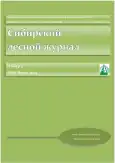SPECIES COMPOSITION AND DIVERSITY OF MICROMAMMALS COMMUNITIES IN FOREST PARK ZONE OF YEKATERINBURG WITH TRANSFORMATION OF FOREST PLANT COMMUNITY
- Authors: Chernousova N.F.1
-
Affiliations:
- Institute of Plant & Animal Ecology, Russian Academy of Sciences, Ural Branch
- Issue: No 3 (2023)
- Pages: 34-41
- Section: RESEARCH ARTICLES
- URL: https://bakhtiniada.ru/2311-1410/article/view/350589
- DOI: https://doi.org/10.15372/SJFS20230305
- ID: 350589
Cite item
Full Text
Abstract
The study of the small mammal communities state in the city’s forest parks and park and in the forest, depending on changes in phytocenoses under the influence of recreation, was carried out. These studies have shown that the lower layers of phytocenoses of the forest communities belonging to pine stand characteristic of the South taiga district of the Trans-Urals foothill forest province (Kolesnikov et al., 1973) have been noticeably changed of the urban area. First of all, we observed a low renewable capacity of the main forest-forming species of the sites and the appearance of new species in the undergrowth, which are not important for forest-forming processes, but are signs of transformation of the lower layers of phytocenosis. The degree of regression digression in all urban sites was medium or weak. In the control it was very weak or absent. In forest parks and park both the extension of the shrub species composition due to synanthropic species and the increase in their number are of greater importance. The undergrowth in them is represented by raspberries ( Rubus idaeus L.), tatarian honeysuckle ( Lonicera tatarica L.), three-lobed viburnum ( Viburnum opulus L.), mountain ash ( Sorbus aucuparia L.), bird cherry ( Prunus padus L.), goat willow ( Salix caprea L.), elderberry ( Sambucus racemosa L.), round-leaved irga ( Amelanchier ovalis Medik.), dogwood ( Cotoneaster Medik.), rosehip ( Rosa acicularis Lindl.), hawthorn ( Crataegus oxyacantha L.). The undergrowth species composition of the control is much poorer than in urban localities: it contains: bird cherry, goat willow, dog rose, green broom ( Chamaecytisus ruthenicus (Fisch. ex Wol.) Klask.), mountain ash. The development of undergrowth is an influence on the growing conditions of grass-shrub species and the development of moss cover with the creation of a regime of favorability for some vegetation groups and suppression of others. Although there is a high similarity in the floral composition of the lower tiers between the forest parks, they differ in the composition of the dominant species. Changes in the lower levels of phytocenoses naturally had an impact on other components of the ecosystem, in particular, on communities of small mammals. In the urban sites appreciable share in the communities is made up of species absent from the forest: Ural field mouse ( Apodemus uralensis Pallas, 1811) and striped field mouse ( A. agrarius Pallas, 1771), which (during the years of depression in the surrounding forests) make up 60 % to 98 % of the community in the forest parks and parks. Comparison of the degree of similarity of the characteristics of the lower layers of phytocenoses and the characteristics of micromammal communities showed their high correspondence.
About the authors
N. F. Chernousova
Institute of Plant & Animal Ecology, Russian Academy of Sciences, Ural Branch
Author for correspondence.
Email: nf_cher@mail.ru
Yekaterinburg, Russian Federation
References
- Бигон М., Харпер Дж., Таунсенд К. Экология. Особи, популяции и сообщества. В 2 т. / Пер. с англ. М.: Мир, 1989. Т. 1. 667 с.
- Колесников Б. П., Зубарева Р. С., Смолоногов Е. П. Лесорастительные условия и типы лесов Свердловской области. Практ. рук-во. Свердловск: Урал. науч. центр АН СССР, 1973. 176 с.
- Маркин Б. М., Ямалов С. М., Наумова Л. Г., Сайфуллина Н. М., Суюндукова Г. Я. Особенности синантропных сообществ как объектов классификации: роль дедуктивного метода // Бюл. МОИП. Отд. биол. 2008. Т. 113. Вып. 4. С. 51-59.
- Новиков Г. А. Полевые исследования по экологии наземных позвоночных. М.: Сов. наука, 1953. 502 с.
- ОСТ 56-100-95. Методы и единицы измерения рекреационных нагрузок на лесные природные комплексы. Утв. Приказом Рослесхоза от 20.07.1995 № 114. (По состоянию на 25.09.2006). М., 1995. 13 с.
- Песенко Ю. А. Принципы и методы количественного анализа в фаунистических исследованиях. М.: Наука, 1982. 260 с.
- Побединский А. В. Изучение лесовосстановительных процессов. М.: Наука, 1966. 64 с.
- Природный комплекс большого города. Ландшафтно-экологический анализ / О. В. Глебова, Э. Г. Коломыц, Г. С. Розенберг, М. В. Сидоренко, В. П. Юнина. М.: Наука; МАИК Наука/Интерпериодика, 2000. 286 c.
- Соловьева В. В., Розенберг Г. С. Современное представление об экотонах или теория экотонов // Усп. совр. биол. 2006. Т. 126. № 6. С. 531-549.
- Тихонова Г. Н., Тихонов И. А., Суров А. В., Богомолов П. Л., Котенкова Е. В. Экологические аспекты формирования фауны мелких млекопитающих урбанистических территорий средней полосы России. М.: Тов-во науч. изд. КМК, 2012. 372 с.
- Черноусова Н. Ф. Динамика численности мелких млекопитающих на урбанизированных территориях // Сиб. экол. жур. 2010. № 1. С. 149-156.
- Черноусова Н. Ф., Толкач О. В., Добротворская О. Е. Сообщества мелких млекопитающих в урбаногенно нарушенных лесных экосистемах // Экология. 2014. № 6. С. 439-447.
- Chernousova N. F. Population dynamics of small mammal species in urbanized areas // Contemp. Probl. Ecol. 2010. V. 3. N. 1. P. 108-113 (Original Rus. text © N. F. Chernousova, 2010, publ. in Sib. Ekol. Zhurn. 2010. V. 17. N. 1. P. 149-156).
- Chernousova N. F., Tolkach O. V., Dobrotvorskaya O. E. Small mammal communities in forest ecosystems affected by urbanization // Rus. J. Ecol. 2014. V. 45. N. 6. Р. 490-497 (Original Rus. text © N. F. Chernousova, O. V. Tolkach, O. E. Dobrotvorskaya, 2014, publ. in Ekologiya. 2014. N. 6. P. 439-447).
- Hammer Ø. Past 3 - the Past of the Future. Univ. Oslo: Natural History Museum, 2022.
- Whittaker R. H. New concepts of kingdoms of organisms // Science. 1969. V. 163. N. 3863. P. 150-160.
Supplementary files










